As an avid coin collector and history buff, I am always fascinated by the designs and artistry of coins and tokens, their countries of origin, and the stories about them. The purpose of this article is to explore one of the most fascinating tokens ever made – Saint Lambert’s Cathedral Communion Tokens, also known as Memento Mori tokens. In order to fully appreciate these beautiful and rare tokens, one needs to know a little bit about church history, what the symbols on the tokens represent, and why they were made. So let’s dive in!
Why Were Communion Tokens Made?
In the mid 1500’s and during the reformation, French Huguenots and Scottish Presbyterians began implementing the use of communion tokens, known in old French as méreau or méreaux . The word méreau comes from the Latin word “ merere ”, meaning to deserve or deserving. After abolition of the Edict of Nantes, Calvinists provided méreaux to their members traveling to other Calvinist communities to distinguish them from Catholic spies. Méreaux entitled their bearers to a Holy Communion and were collected by the priest serving the Communion.
These tokens were also used in churches to record attendance at chapter meetings, attendance at certain offices and to pay for attendance at processions. It is believed that the primary purpose of these tokens was to represent a symbol that a parishioner who had one needed to pass a personal spiritual examination of their life prior to taking communion. This was an act of devotion and to heed the warning written in the book of 1 Corinthians 11:23-31 , which states: “ For I received from the Lord what I also passed on to you: The Lord Jesus, on the night he was betrayed, took bread, and when he had given thanks, he broke it and said, “This is my body, which is for you; do this in remembrance of me.” In the same way, after supper he took the cup, saying, “This cup is the new covenant in my blood; do this, whenever you drink it, in remembrance of me.” For whenever you eat this bread and drink this cup, you proclaim the Lord’s death until he comes. Therefore, whoever eats the bread or drinks the cup of the Lord in an unworthy manner will be guilty of sinning against the body and blood of the Lord. A man ought to examine himself before he eats of the bread and drinks of the cup. For anyone who eats and drinks without recognizing the body of the Lord eats and drinks judgment on himself. That is why many among you are weak and sick, and a number of you have fallen asleep. But if we judged ourselves, we would not come under judgment .”
Even though communion tokens were used as a means to reflect on the eventuality of death, ministers of the gospel were also responsible to encourage their congregation and share the positive aspects of the faith as well as the promises that a follower of Christ is destined to inherit .
Latin – The Language of The Church
During the period Saint Lambert communion tokens were used, the universal language of the Roman Catholic church was Latin. In Latin, there are three very important phrases that were instrumental to the faith, one is “ gratia estis salvati ” which means “ By grace you are saved ”. This comes from the book of Ephesians 2:8-9 which says: “ For it is by grace you have been saved, through faith—and this is not from yourselves, it is the gift of God—not by works, so that no one can boast. ” The second phrase is “ donum dei vita aeterna per Iesum Christum ”, which means “ the gift of god is eternal life through Jesus Christ ”. This comes from the book of Romans 6:23 , which says: “ For the wages of sin is death, but the gift of God is eternal life in Christ Jesus our Lord .”
The third sentence, which likely had some influence in the design of the tokens is “Absorpta est mors in Victoria ”, which means “ Death has been swallowed up in victory ”. This phrase comes from the book of 1 Corinthians 15:54-55 , which says: When the perishable has been clothed with the imperishable, and the mortal with immortality, then the saying that is written will come true: “Death has been swallowed up in victory .” “ Where, O death, is your victory?” Where, O death, is your sting ?”
 Before taking communion, the elders of the church would interview each person and distribute the tokens to those who prepared their hearts to receive it. Prior to taking the communion elements (typically bread and wine), the believer would give the token to the minister. In addition to being used for communion, these tokens were also likely used during the feast day celebrations commemorating the anniversary of St. Lambert’s remains being placed in the cathedral at Liège.
Before taking communion, the elders of the church would interview each person and distribute the tokens to those who prepared their hearts to receive it. Prior to taking the communion elements (typically bread and wine), the believer would give the token to the minister. In addition to being used for communion, these tokens were also likely used during the feast day celebrations commemorating the anniversary of St. Lambert’s remains being placed in the cathedral at Liège.
At least four out of the five Saint Lambert tokens were made while Maximilian Henry of Bavaria (1621 – 1688) was the Bishop of Liège. In 1650, he was named Archbishop-Elector of Cologne, Bishop of Hildesheim and Bishop of Liège. He worked throughout his career with the French to limit the authority of the Holy Roman Emperor, and participated in the Franco-Dutch War on the opposite side from the Empire. The first and rarest Saint Lambert token was made in 1635, when Ferdinand of Bavaria (1577 – 1650) was the Prince Bishop of Liège.
The Prince-Bishopric of Liège or Principality of Liège was an ecclesiastical principality (territory ruled by a bishop as a prince) of the Holy Roman Empire that was situated for the most part in present-day Belgium. It was an Imperial Estate, so the bishop of Liège, as its prince, had a seat and a vote in the Imperial Diet (the deliberative body of the Holy Roman Empire). The Prince-Bishopric of Liège should not be confused with the Diocese of Liège, which was larger and over which the prince-bishop exercised only the usual responsibilities of a bishop. For more information on Maximilian Henry of Bavaria, visit: https://en.wikipedia.org/wiki/Maximilian_Henry_of_Bavaria For more information on The Prince-Bishopric of Liège or Principality of Liège visit: https://en.wikipedia.org/ wiki/Prince-Bishopric_of_Li%C3%A8ge
The History of Lambert of Maastricht “Saint Lambert” (c 635-c 700)
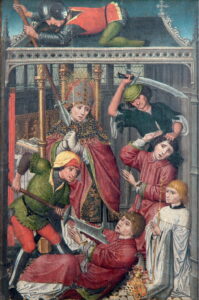 Lambert of Maastricht, commonly referred to as Saint Lambert (c. 636 AD – c. 705 AD) was born in Maestricht, a city in the province of Flanders (now known as the Netherlands). He was the bishop of Maastricht-Liège from about 670 AD until his death. He is described by early biographers as “ a prudent young man of pleasant looks, courteous and well-behaved in his speech and manners, well-built, strong, a good fighter, clear-headed, affectionate, pure and humble and fond of reading . As a young man he wrought miracles, one day bringing forth a spring to quench the thirst of some workers building a church, and in this way he became known to everyone in the city .”
Lambert of Maastricht, commonly referred to as Saint Lambert (c. 636 AD – c. 705 AD) was born in Maestricht, a city in the province of Flanders (now known as the Netherlands). He was the bishop of Maastricht-Liège from about 670 AD until his death. He is described by early biographers as “ a prudent young man of pleasant looks, courteous and well-behaved in his speech and manners, well-built, strong, a good fighter, clear-headed, affectionate, pure and humble and fond of reading . As a young man he wrought miracles, one day bringing forth a spring to quench the thirst of some workers building a church, and in this way he became known to everyone in the city .”
While few details of St. Lambert’s life are known, historians and religious scholars have agreed that he was murdered as a result of admonishing the Merovingian Duke Pepin II (Pepin of Herstal) for adultery with a noblewoman named Alpaida. This illicit union between Pepin II and Alpaida later led to the birth of Charles Martel (“The Hammer” 688 –741) and Childebrand I (678–751). Charles Martel took over after his father’s death and went on to end the Muslims’ inroads into Western Europe at the Battle of Tours, and become the grandfather of Charlemagne (742–814), the first Holy Roman Emperor.
The admonishment issued by Saint Lambert humiliated Pepin and Alpaida, so they had him murdered. St. Lambert is said to have been killed with a javelin during mass in Liege’s Chapel of Saints Cosmas & Damian by soldiers under the command of Alpaida’s family. Saint Lambert’s two nephews, Peter and Audolet, were also killed defending their uncle.
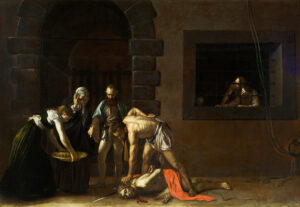 Many believe that Saint Lambert’s deep conviction to defend Holy matrimony stemmed from the example set by John the Baptist when he confronted King Herod. “ Now Herod had arrested John and bound him and put him in prison because of Herodias, his brother Philip’s wife, for John had been saying to him : “ It is not lawful for you to have her .” Herod wanted to kill John, but he was afraid of the people, because they considered John a prophet. On Herod’s birthday the daughter of Herodias danced for the guests and pleased Herod so much that he promised with an oath to give her whatever she asked. Prompted by her mother, she said, “Give me here on a platter the head of John the Baptist.” The king was distressed, but because of his oaths and his dinner guests, he ordered that her request be granted and had John beheaded in the prison. His head was brought in on a platter and given to the girl, who carried it to her mother. John’s disciples came and took his body and buried it .” Matthew 14:3-14 .
Many believe that Saint Lambert’s deep conviction to defend Holy matrimony stemmed from the example set by John the Baptist when he confronted King Herod. “ Now Herod had arrested John and bound him and put him in prison because of Herodias, his brother Philip’s wife, for John had been saying to him : “ It is not lawful for you to have her .” Herod wanted to kill John, but he was afraid of the people, because they considered John a prophet. On Herod’s birthday the daughter of Herodias danced for the guests and pleased Herod so much that he promised with an oath to give her whatever she asked. Prompted by her mother, she said, “Give me here on a platter the head of John the Baptist.” The king was distressed, but because of his oaths and his dinner guests, he ordered that her request be granted and had John beheaded in the prison. His head was brought in on a platter and given to the girl, who carried it to her mother. John’s disciples came and took his body and buried it .” Matthew 14:3-14 .
After St. Lambert’s martyrdom, his body was buried at Maestricht. Later, it was moved to Liège, in the Eastern part of modern Belgium, where his relics are honored to this day. For more information on Saint Lambert, visit: https://en.wikipedia.org/wiki/Lambert_of_Maastricht
St. Lambert Token’s Design Elements – There’s More Than What Meets The Eye!
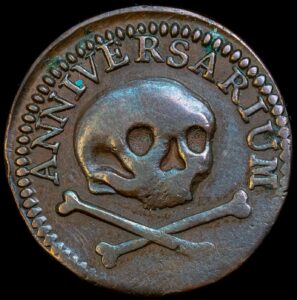 Most will agree that the design of Saint Lambert communion tokens are quite striking and mysterious. The image of a skull and crossbones on the obverse might appear to some as a symbol of the occult or some affiliation with the SS of Nazi Germany. In reality, the skull and crossbones images date back thousands of years and are known as “Memento Mori ”, which is a Latin term for “ Remember death” or “remember you must die.” Another Latin phrase that often accompanies Memento Mori is the phrase “Carpe Diem“, which translates to “seize the moment“.
Most will agree that the design of Saint Lambert communion tokens are quite striking and mysterious. The image of a skull and crossbones on the obverse might appear to some as a symbol of the occult or some affiliation with the SS of Nazi Germany. In reality, the skull and crossbones images date back thousands of years and are known as “Memento Mori ”, which is a Latin term for “ Remember death” or “remember you must die.” Another Latin phrase that often accompanies Memento Mori is the phrase “Carpe Diem“, which translates to “seize the moment“.
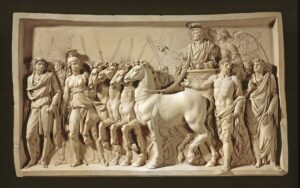 In ancient Rome after a major military victory, the triumphant general, known as a “triumphator” would be cloaked in royal purple and ride in a golden chariot drawn by four horses. He was paraded through the streets in a grand procession with his army, prisoners, and the spoilers of war. There was not a more coveted honor. The general was idolized, viewed as divine by his troops and the public alike. But riding in the same chariot, standing just behind the worshiped general, was a slave. The slave’s sole responsibility for the entirety of the procession was to whisper in the general’s ear continuously, “ Respice post te. Hominem te esse memento. Memento mori !” “ Look behind you. Remember you are human. Remember you must die !” The slave served to remind the victor at the peak of glory, this god-like adoration would soon end, while the truth of his mortality remained. For more on the history of Roman processions, visit: https://www.worldhistory.org/Roman_Triumph/
In ancient Rome after a major military victory, the triumphant general, known as a “triumphator” would be cloaked in royal purple and ride in a golden chariot drawn by four horses. He was paraded through the streets in a grand procession with his army, prisoners, and the spoilers of war. There was not a more coveted honor. The general was idolized, viewed as divine by his troops and the public alike. But riding in the same chariot, standing just behind the worshiped general, was a slave. The slave’s sole responsibility for the entirety of the procession was to whisper in the general’s ear continuously, “ Respice post te. Hominem te esse memento. Memento mori !” “ Look behind you. Remember you are human. Remember you must die !” The slave served to remind the victor at the peak of glory, this god-like adoration would soon end, while the truth of his mortality remained. For more on the history of Roman processions, visit: https://www.worldhistory.org/Roman_Triumph/
Memento mori symbols can be seen on some Roman and early Christian tombs, the Knights Templar used it around the 13th century, and even pirates used variations of it on their flags.
Whether these tokens were used to participate in communion, anniversary feasts, attendance at funerals, or other church functions, the message they convey is that we are all mortal and need to consider where we will spend eternity.
The Inspiration Behind The Design
To get a better feeling of what may have gone through the mind of the designers and die engravers of these tokens, you have to remember that these tokens were specifically made for the Cathedral of Saint Lambert in Liège about a thousand years after the saint’s death.
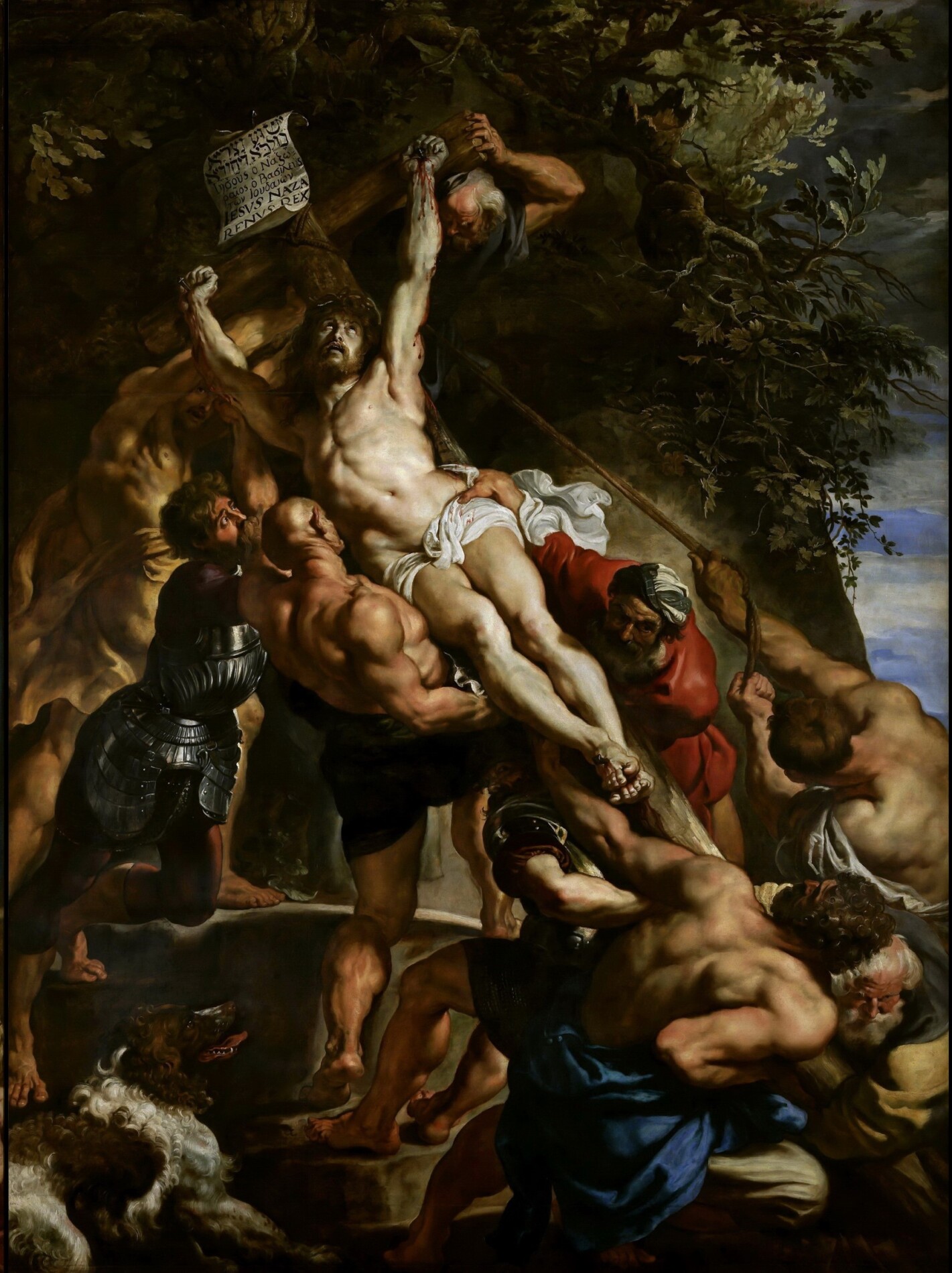 The skull and crossed bones imagery on the obverse is most likely a reference to Christ’s victory over death, which was prophesied roughly 700 years before Jesus was born. This is illustrated in the 53rd chapter of the book of Isaiah, a chapter in the Old Testament often referred to as “the forbidden chapter“. It reads: “Who has believed our message and to whom has the arm of the Lord been revealed? 2 He grew up before him like a tender shoot, and like a root out of dry ground. He had no beauty or majesty to attract us to him, nothing in his appearance that we should desire him. 3 He was despised and rejected by mankind, a man of suffering, and familiar with pain. Like one from whom people hide their faces he was despised, and we held him in low esteem. 4 Surely he took up our pain and bore our suffering, yet we considered him punished by God, stricken by him, and afflicted. 5 But he was pierced for our transgressions, he was crushed for our iniquities; the punishment that brought us peace was on him, and by his wounds we are healed. 6 We all, like sheep, have gone astray, each of us has turned to our own way; and the Lord has laid on him the iniquity of us all. 7 He was oppressed and afflicted, yet he did not open his mouth; he was led like a lamb to the slaughter, and as a sheep before its shearers is silent, so he did not open his mouth. 8 By oppression and judgment he was taken away. Yet who of his generation protested? For he was cut off from the land of the living; for the transgression of my people he was punished.9 He was assigned a grave with the wicked, and with the rich in his death, though he had done no violence, nor was any deceit in his mouth. 10 Yet it was the Lord’s will to crush him and cause him to suffer, and though the Lord makes his life an offering for sin, he will see his offspring and prolong his days, and the will of the Lord will prosper in his hand.11 After he has suffered, he will see the light of life and be satisfied; by his knowledge my righteous servant will justify many, and he will bear their iniquities. 12 Therefore I will give him a portion among the great, and he will divide the spoils with the strong, because he poured out his life unto death, and was numbered with the transgressors. For he bore the sin of many, and made intercession for the transgressors.”
The skull and crossed bones imagery on the obverse is most likely a reference to Christ’s victory over death, which was prophesied roughly 700 years before Jesus was born. This is illustrated in the 53rd chapter of the book of Isaiah, a chapter in the Old Testament often referred to as “the forbidden chapter“. It reads: “Who has believed our message and to whom has the arm of the Lord been revealed? 2 He grew up before him like a tender shoot, and like a root out of dry ground. He had no beauty or majesty to attract us to him, nothing in his appearance that we should desire him. 3 He was despised and rejected by mankind, a man of suffering, and familiar with pain. Like one from whom people hide their faces he was despised, and we held him in low esteem. 4 Surely he took up our pain and bore our suffering, yet we considered him punished by God, stricken by him, and afflicted. 5 But he was pierced for our transgressions, he was crushed for our iniquities; the punishment that brought us peace was on him, and by his wounds we are healed. 6 We all, like sheep, have gone astray, each of us has turned to our own way; and the Lord has laid on him the iniquity of us all. 7 He was oppressed and afflicted, yet he did not open his mouth; he was led like a lamb to the slaughter, and as a sheep before its shearers is silent, so he did not open his mouth. 8 By oppression and judgment he was taken away. Yet who of his generation protested? For he was cut off from the land of the living; for the transgression of my people he was punished.9 He was assigned a grave with the wicked, and with the rich in his death, though he had done no violence, nor was any deceit in his mouth. 10 Yet it was the Lord’s will to crush him and cause him to suffer, and though the Lord makes his life an offering for sin, he will see his offspring and prolong his days, and the will of the Lord will prosper in his hand.11 After he has suffered, he will see the light of life and be satisfied; by his knowledge my righteous servant will justify many, and he will bear their iniquities. 12 Therefore I will give him a portion among the great, and he will divide the spoils with the strong, because he poured out his life unto death, and was numbered with the transgressors. For he bore the sin of many, and made intercession for the transgressors.”
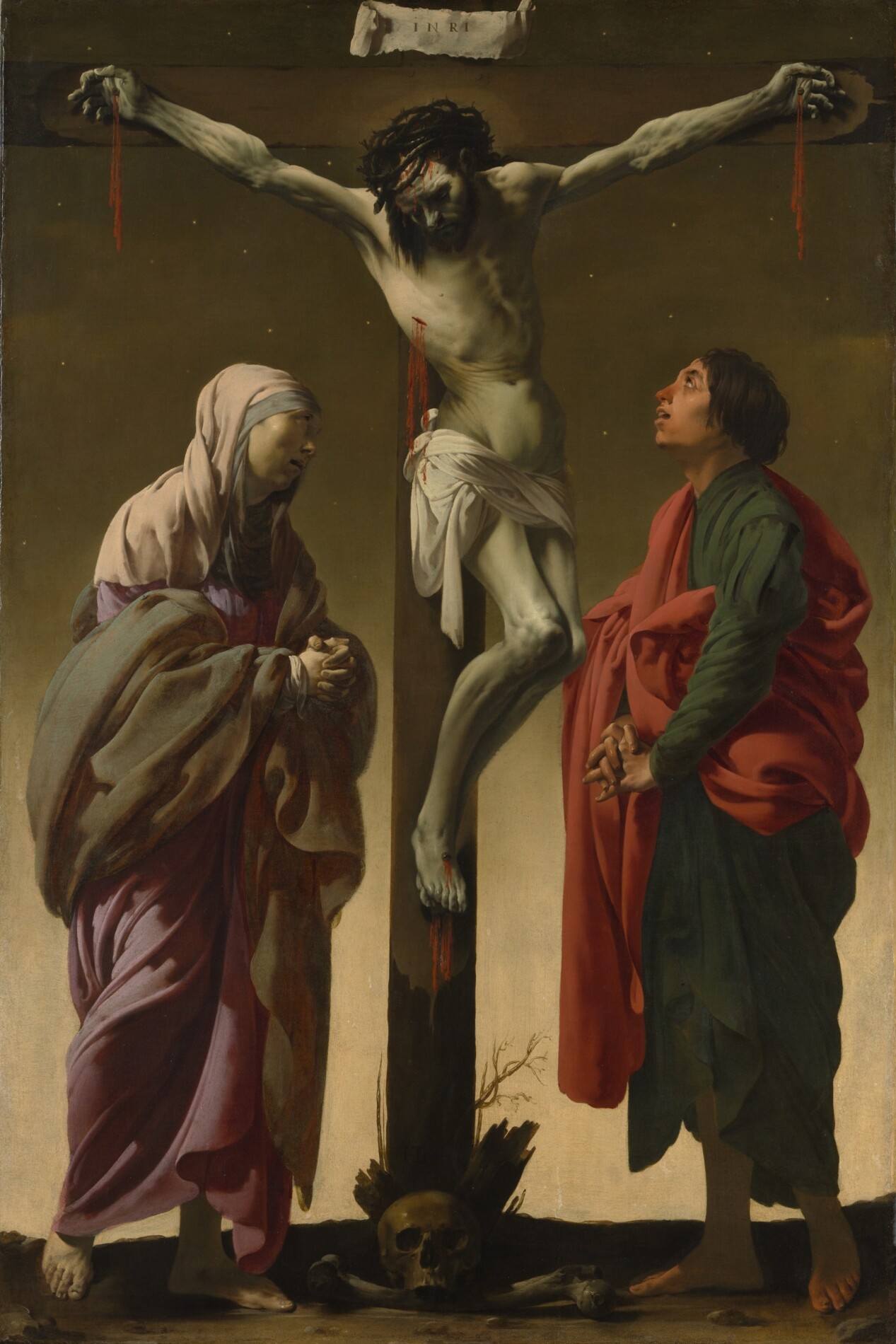 The fulfillment of this prophesy is documented in all four gospels and in the book of Matthew chapter 27, it reads: “They came to a place called Golgotha (which means “the place of the skull”). 34 There they offered Jesus wine to drink, mixed with gall; but after tasting it, he refused to drink it. 35 When they had crucified him, they divided up his clothes by casting lots. 36 And sitting down, they kept watch over him there. 37 Above his head they placed the written charge against him: this is Jesus, the king of the jews. 38 Two rebels were crucified with him, one on his right and one on his left. 39 Those who passed by hurled insults at him, shaking their heads 40 and saying, “You who are going to destroy the temple and build it in three days, save yourself! Come down from the cross, if you are the Son of God!” 41 In the same way the chief priests, the teachers of the law and the elders mocked him. 42 “He saved others,” they said, “but he can’t save himself! He’s the king of Israel! Let him come down now from the cross, and we will believe in him. 43 He trusts in God. Let God rescue him now if he wants him, for he said, ‘I am the Son of God.’” 44 In the same way the rebels who were crucified with him also heaped insults on him. 45 From noon until three in the afternoon darkness came over all the land. 46 About three in the afternoon Jesus cried out in a loud voice, “Eli, Eli, lema sabachthani?” (which means “My God, my God, why have you forsaken me?”). 47 When some of those standing there heard this, they said, “He’s calling Elijah.” 48 Immediately one of them ran and got a sponge. He filled it with wine vinegar, put it on a staff, and offered it to Jesus to drink. 49 The rest said, “Now leave him alone. Let’s see if Elijah comes to save him.” 50 And when Jesus had cried out again in a loud voice, he gave up his spirit. 51 At that moment the curtain of the temple was torn in two from top to bottom. The earth shook, the rocks split 52 and the tombs broke open. The bodies of many holy people who had died were raised to life. 53 They came out of the tombs after Jesus’ resurrection and[e] went into the holy city and appeared to many people. 54 When the centurion and those with him who were guarding Jesus saw the earthquake and all that had happened, they were terrified, and exclaimed, “Surely he was the Son of God!”
The fulfillment of this prophesy is documented in all four gospels and in the book of Matthew chapter 27, it reads: “They came to a place called Golgotha (which means “the place of the skull”). 34 There they offered Jesus wine to drink, mixed with gall; but after tasting it, he refused to drink it. 35 When they had crucified him, they divided up his clothes by casting lots. 36 And sitting down, they kept watch over him there. 37 Above his head they placed the written charge against him: this is Jesus, the king of the jews. 38 Two rebels were crucified with him, one on his right and one on his left. 39 Those who passed by hurled insults at him, shaking their heads 40 and saying, “You who are going to destroy the temple and build it in three days, save yourself! Come down from the cross, if you are the Son of God!” 41 In the same way the chief priests, the teachers of the law and the elders mocked him. 42 “He saved others,” they said, “but he can’t save himself! He’s the king of Israel! Let him come down now from the cross, and we will believe in him. 43 He trusts in God. Let God rescue him now if he wants him, for he said, ‘I am the Son of God.’” 44 In the same way the rebels who were crucified with him also heaped insults on him. 45 From noon until three in the afternoon darkness came over all the land. 46 About three in the afternoon Jesus cried out in a loud voice, “Eli, Eli, lema sabachthani?” (which means “My God, my God, why have you forsaken me?”). 47 When some of those standing there heard this, they said, “He’s calling Elijah.” 48 Immediately one of them ran and got a sponge. He filled it with wine vinegar, put it on a staff, and offered it to Jesus to drink. 49 The rest said, “Now leave him alone. Let’s see if Elijah comes to save him.” 50 And when Jesus had cried out again in a loud voice, he gave up his spirit. 51 At that moment the curtain of the temple was torn in two from top to bottom. The earth shook, the rocks split 52 and the tombs broke open. The bodies of many holy people who had died were raised to life. 53 They came out of the tombs after Jesus’ resurrection and[e] went into the holy city and appeared to many people. 54 When the centurion and those with him who were guarding Jesus saw the earthquake and all that had happened, they were terrified, and exclaimed, “Surely he was the Son of God!”
The flame symbols on the reverse of four of the five varieties have biblical significance and most likely represent the life transforming power of the Holy Spirit. Jesus told his disciples: “And , behold, I send the promise of my Father upon you: but tarry ye in the city of Jerusalem, until ye be endued with power from on high .” (Luke 24:49) Then the book of Acts 2:1-3 states: “ And when the day of Pentecost was fully come, they were all with one agreement in one place. And suddenly there came a sound from heaven as of a rushing mighty wind, and it filled all the house where they were sitting. And there appeared unto them cloven tongues like as of fire, and it sat upon each of them .”
 The flame images may also represent Moses’s encounter with the burning bush found in Exodus 3:1-6 . “ Now Moses was tending the flock of Jethro his father-in-law, the priest of Midian, and he led the flock to the far side of the wilderness and came to Horeb, the mountain of God. There the angel of the Lord appeared to him in flames of fire from within a bush. Moses saw that though the bush was on fire it did not burn up. So Moses thought, “I will go over and see this strange sight—why the bush does not burn up.” When the Lord saw that he had gone over to look, God called to him from within the bush, “Moses! Moses!” And Moses said, “Here I am.” “Don’t come any closer,” God said. “Take off your sandals, for the place where you are standing is holy ground. ” Then he said, “ I am the God of your father, the God of Abraham, the God of Isaac and the God of Jacob.” At this, Moses hid his face, because he was afraid to look at God .”
The flame images may also represent Moses’s encounter with the burning bush found in Exodus 3:1-6 . “ Now Moses was tending the flock of Jethro his father-in-law, the priest of Midian, and he led the flock to the far side of the wilderness and came to Horeb, the mountain of God. There the angel of the Lord appeared to him in flames of fire from within a bush. Moses saw that though the bush was on fire it did not burn up. So Moses thought, “I will go over and see this strange sight—why the bush does not burn up.” When the Lord saw that he had gone over to look, God called to him from within the bush, “Moses! Moses!” And Moses said, “Here I am.” “Don’t come any closer,” God said. “Take off your sandals, for the place where you are standing is holy ground. ” Then he said, “ I am the God of your father, the God of Abraham, the God of Isaac and the God of Jacob.” At this, Moses hid his face, because he was afraid to look at God .”
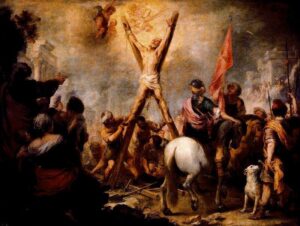 All five varieties of Saint Lambert communion tokens have a skull and crossbones on the obverse. However, on the obverse of the first variety dated to 1635 you see the typical skull and crossbones, only here the skull is superimposed over the crossbones in a saltire or Saint Andrews cross pattern. This is significant as early church historians state that St. Andrew was condemned to death by crucifixion by the Romans in the city of Patras, Greece in AD 60 and asked to be crucified on a diagonal cross as he felt unworthy to die on the same shape of cross as Jesus. Tradition also says that the Romans rotated the traditional cross onto its side as an insult. For more information on Andrew the Apostle, visit: https://en.wikipedia.org/wiki/Andrew_the_Apostle
All five varieties of Saint Lambert communion tokens have a skull and crossbones on the obverse. However, on the obverse of the first variety dated to 1635 you see the typical skull and crossbones, only here the skull is superimposed over the crossbones in a saltire or Saint Andrews cross pattern. This is significant as early church historians state that St. Andrew was condemned to death by crucifixion by the Romans in the city of Patras, Greece in AD 60 and asked to be crucified on a diagonal cross as he felt unworthy to die on the same shape of cross as Jesus. Tradition also says that the Romans rotated the traditional cross onto its side as an insult. For more information on Andrew the Apostle, visit: https://en.wikipedia.org/wiki/Andrew_the_Apostle
In addition to Saint Lambert communion tokens depicting a Memento Mori motif, Dutch artists from the same period also created illustrations known as “Vanitas” or vanities, that further illustrated the mortality of mankind.
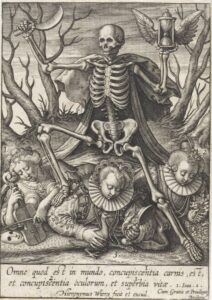 The illustration to the left came from the Rijksmuseum in the Netherlands and was created by Flemish engraver Hieronymus Wierix (1553–1619). This work is titled the “Allegory of Impermanence of Vanities”. The Latin inscription below the illustration reads: “Omne quod es t in Mundo concupiscentia carnis es t et concupiscentia oculorum et superbia vitae”, which is a reference to 1 John 2:16-17, which reads: “For everything in the world—the lust of the flesh, the lust of the eyes, and the pride of life—comes not from the Father but from the world. 17 The world and its desires pass away, but whoever does the will of God lives forever.”
The illustration to the left came from the Rijksmuseum in the Netherlands and was created by Flemish engraver Hieronymus Wierix (1553–1619). This work is titled the “Allegory of Impermanence of Vanities”. The Latin inscription below the illustration reads: “Omne quod es t in Mundo concupiscentia carnis es t et concupiscentia oculorum et superbia vitae”, which is a reference to 1 John 2:16-17, which reads: “For everything in the world—the lust of the flesh, the lust of the eyes, and the pride of life—comes not from the Father but from the world. 17 The world and its desires pass away, but whoever does the will of God lives forever.”
The image depicts death trampling on three female allegorical figures who are focused downward or things of the Earth. Death is holding an hourglass with wings in his left hand illustrating that time is flying away and a scythe in his right hand denoting that death is looming over your head. The woman on the left (numbered 1) plays a violin and has a theatrical mask, representing “concupiscentia carnis” (carnality and being two-faced); the woman on the right (numbered 2) holds a flowering plant, representing “concupiscentia oculorum” (wealth and opulence); and the woman in the center (numbered 3) holds a peacock and a mirror, representing “superbia vitæ” (pride in one’s self, accomplishments and appearance; the personification of one of the Seven Deadly Sins)
The Five Types of Saint Lambert’s Communion Tokens
There are five types of Saint Lambert tokens, all of which were likely minted on a screw press versus being hammer struck. The weight of the tokens can vary from about 4.5 grams to 5.5 grams and the general diameter is roughly 22 mm. In 1550 the German silversmith Max Schwab of Augsburg invented a new way of minting coins, which improved the quality of the coin and increased the rate of production. First, he devised a rolling mill where uniform strips of metal (copper or bronze in this case) could be made into a desired width and thickness. Once the metal was in strip form, the strip could then be punched by a heavy punch press that cut out round blanks called planchets.  Once the planchets were cut out, they were heated and placed on a heavy iron screw press that had an obverse and reverse die set facing opposite each other so both sides of a coin could be impressed into the metal at the same time.
Once the planchets were cut out, they were heated and placed on a heavy iron screw press that had an obverse and reverse die set facing opposite each other so both sides of a coin could be impressed into the metal at the same time.
Henri II of France (1547-1559) imported these coin minting machines, but met with hostility by the local coin makers (moneyers) who made their living making hammered coins, so the screw press process was only to be used for coins of low value , such as medals and tokens. It wasn’t until 1645 that the screw press came into general use for minting coins. For more information on screw presses and how they were used, visit: https://www.thevintagenews.com/2016/03/03/the-early-modern-period-striking-coins-with-a-screw-press/
Keep in mind that although there are only five types of Saint Lambert’s Communion tokens, there are a variety of die variations for each issue. Here are some general details of each that may be helpful:
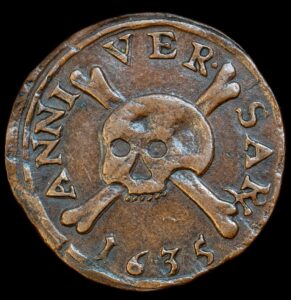 Token #1 Obverse (die variety 1): This is the first year of issue for the Memento Mori variety of communion tokens and by far the rarest. On this type, the bones are larger and interrupt the legend. The skull has a single triangular nose, six teeth and no lower jaw. Skull faces to the left superimposed on a saltire cross of bones. The skull also has two curious indentations that likely represent wounds or skull damage and a single eyeball in the left eye socket. A variety of this type exists that shows five teeth on the skull instead of six. This token was made when Ferdinand of Bavaria (1577 – 1650) was the Prince Bishop of Liège.
Token #1 Obverse (die variety 1): This is the first year of issue for the Memento Mori variety of communion tokens and by far the rarest. On this type, the bones are larger and interrupt the legend. The skull has a single triangular nose, six teeth and no lower jaw. Skull faces to the left superimposed on a saltire cross of bones. The skull also has two curious indentations that likely represent wounds or skull damage and a single eyeball in the left eye socket. A variety of this type exists that shows five teeth on the skull instead of six. This token was made when Ferdinand of Bavaria (1577 – 1650) was the Prince Bishop of Liège.
Legend Description: ANNI. VER. SARY (Latin for Anniversary). Note that the “R” and “Y” in ANNIVERSARY are combined as one letter or ligature.
Date: 1635
Composition: Likely Bronze
Diameter: 19.5 mm – 21.8 mm
Weight: 2.44 – 4.04 grams
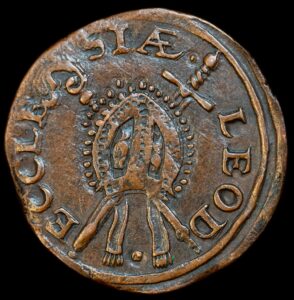 Token #1 Reverse: A bishop’s miter (a headdress worn by Roman Catholic bishops) in front of a crozier or crosier (a hooked staff carried by a bishop as a symbol of pastoral office) and a sword. Here is an example: https://en.wikipedia.org/wiki/Crosier
Token #1 Reverse: A bishop’s miter (a headdress worn by Roman Catholic bishops) in front of a crozier or crosier (a hooked staff carried by a bishop as a symbol of pastoral office) and a sword. Here is an example: https://en.wikipedia.org/wiki/Crosier
Legend Description: ECCLE.SIÆ.LEOD (This is an abbreviation for “Dioecesis Leodiensis” for “Of The Church Liège” or “Diocese of Liège” (which was a much a larger territory). The Latin character “Ӕ” is used instead of AE for ECCLESIӔ. Æ is a ligature where a single character is formed by joining two or more letters. Pronounced phonetically, “Æ” sounds like the “i” in the word “aisle.” Early scribes, map cartographers, and die engravers often joined these two letters into a ligature. Varieties minted after 1653 dropped the “Æ”.
Reference: Renesse Plate 71 #2, OL Eklund #82
Note: This is the rarest of all the varieties.
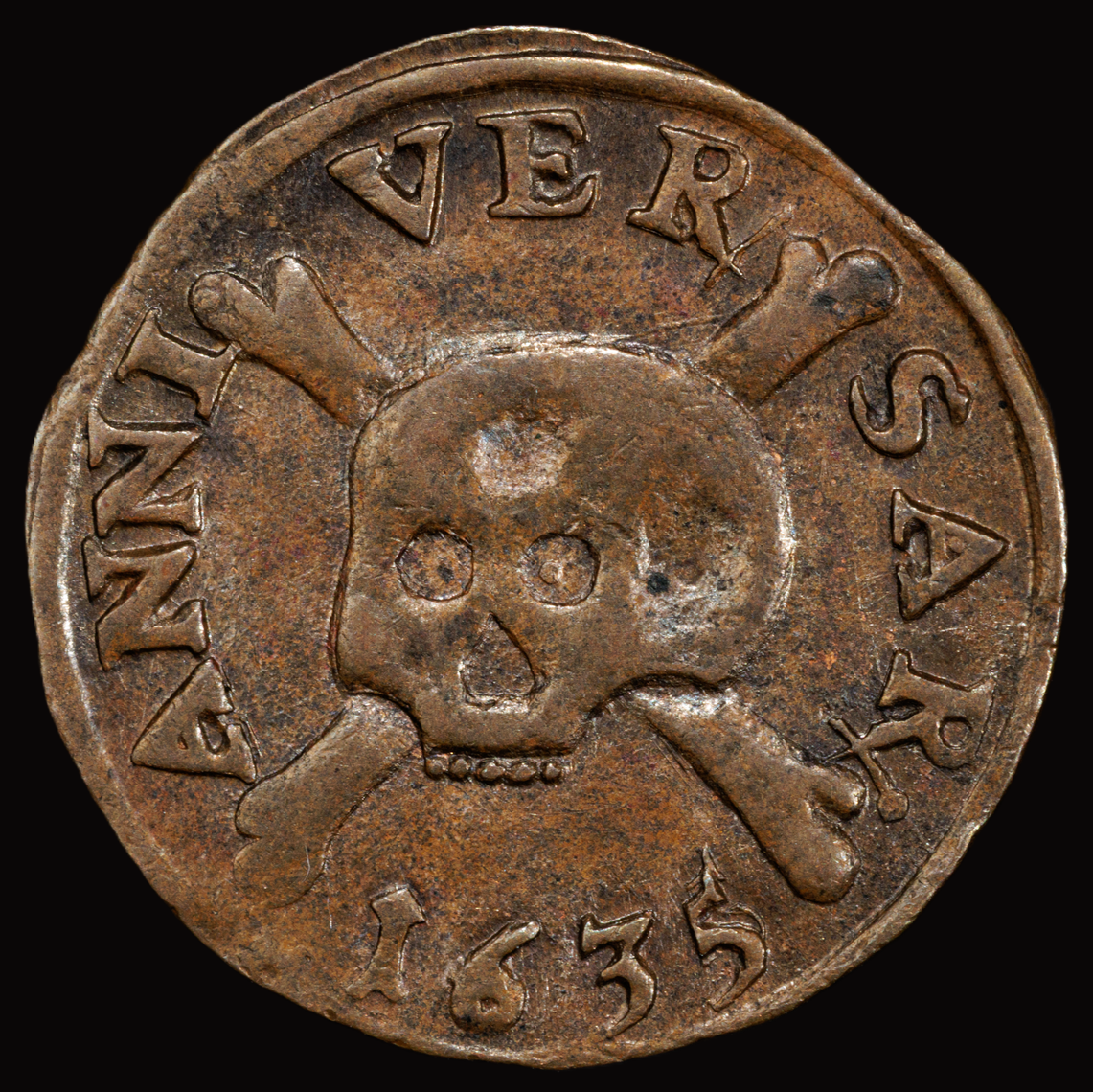 Token #1 Obverse (die variety #2): If you look closely at the specimen to the left, this die variety shows a couple of interesting differences from variety #1. First, the skull on this variety has five teeth versus six. Second, the “5” in 1635 is double struck and the other date digits appear to be a noticeably different style. Although the die engraver did his best to make the dies the same, these subtle differences prove that more than one die was used. For more photos of this example, visit: https://www.pcgs.com/cert/57235953
Token #1 Obverse (die variety #2): If you look closely at the specimen to the left, this die variety shows a couple of interesting differences from variety #1. First, the skull on this variety has five teeth versus six. Second, the “5” in 1635 is double struck and the other date digits appear to be a noticeably different style. Although the die engraver did his best to make the dies the same, these subtle differences prove that more than one die was used. For more photos of this example, visit: https://www.pcgs.com/cert/57235953
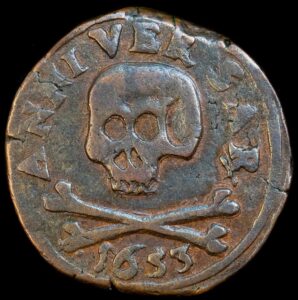 Token #2 Obverse: A somewhat crude skull without a lower jaw looking left with two crossed bones underneath. Skull shows two nostrils and four teeth. Planchets tend to show multiple cracks. This token was made when Maximilian Henry of Bavaria (1621-1688) was the Prince Bishop of Liège.
Token #2 Obverse: A somewhat crude skull without a lower jaw looking left with two crossed bones underneath. Skull shows two nostrils and four teeth. Planchets tend to show multiple cracks. This token was made when Maximilian Henry of Bavaria (1621-1688) was the Prince Bishop of Liège.
Legend Description: ANNIVERSAR (Latin for “Anniversary”) Under the crossed bones
Date: 1653
Composition: Likely copper
Diameter: 20.00 mm – 21.9 mm
Weight: 3.73 – 5.29 grams
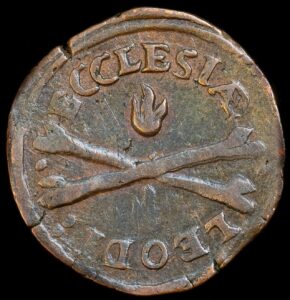 Token #2 Reverse: Tongues of fire each set above and below two crossed bones. A single dot is present between the ends of the bones and double dots after LEODI. This variety tends to look crude even in high grades.
Token #2 Reverse: Tongues of fire each set above and below two crossed bones. A single dot is present between the ends of the bones and double dots after LEODI. This variety tends to look crude even in high grades.
Legend Description: ECCLESIÆ LEODI (Latin for “Of The Church Liège”) The Latin character “Ӕ” is used instead of AE for ECCLESIӔ.
Reference: Renesse Plate 71 #3 OL Eklund #83
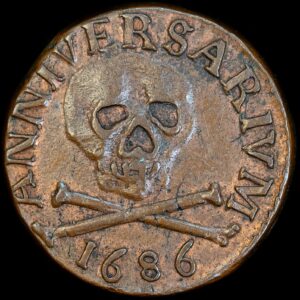 Token #3 Obverse: Detailed full skull facing forward with crossed bones underneath and date below the bones. A rope design around the outer edge of the plank. This token was made when Maximilian Henry of Bavaria (1621-1688) was the Prince Bishop of Liège.
Token #3 Obverse: Detailed full skull facing forward with crossed bones underneath and date below the bones. A rope design around the outer edge of the plank. This token was made when Maximilian Henry of Bavaria (1621-1688) was the Prince Bishop of Liège.
Legend Description: ANNIVERSARIVM (Latin for Anniversary)
Date: 1686
Composition: Likely copper
Diameter: 19.8 mm – 21.5 mm
Weight: 4.00 – 4.63 grams
Note: Later versions of this token have a large die crack from the right side of the skull that obscures the “R” in ANNIVERSARIVM. The crack resembles a skull with a snorkel in its mouth. See last image.
 Token #3 Reverse: Tongues of fire each set above and below two crossed bones. A double dot is typically present after “ECCLESI:”, before “:LEODI” and after the “I” in “LEODI:”. The word “LEODI” is oriented upside down. A rope design may be present around the outer perimeter of the plank.
Token #3 Reverse: Tongues of fire each set above and below two crossed bones. A double dot is typically present after “ECCLESI:”, before “:LEODI” and after the “I” in “LEODI:”. The word “LEODI” is oriented upside down. A rope design may be present around the outer perimeter of the plank.
Legend Description: ECCLESI LEODI (Latin for “The Church of Liège”)
Reference: Renesse Plate 71 #4, OL Eklund #84
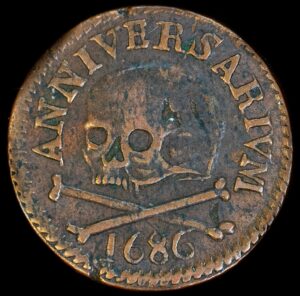 Token #4 Obverse: Detailed skull without lower jaw facing left with crossed bones underneath and date below the bones. Eight teeth. A rope design around the outer edge of the plank. This token was made when Maximilian Henry of Bavaria (1621-1688) was the Prince Bishop of Liège.
Token #4 Obverse: Detailed skull without lower jaw facing left with crossed bones underneath and date below the bones. Eight teeth. A rope design around the outer edge of the plank. This token was made when Maximilian Henry of Bavaria (1621-1688) was the Prince Bishop of Liège.
Legend Description: ANNIVERSARIVM (Latin for Anniversary)
Date: 1686
Composition: Likely bronze
Diameter: 20.4 mm – 21.00 mm
Weight: 4.34 – 5.06 grams
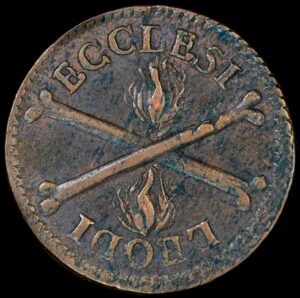 Token #4 Reverse: Tongues of fire each set above and below two crossed bones. No dots are used between the words. The word “LEODI” is oriented upside down. A rope design may be present around the outer perimeter of the plank.
Token #4 Reverse: Tongues of fire each set above and below two crossed bones. No dots are used between the words. The word “LEODI” is oriented upside down. A rope design may be present around the outer perimeter of the plank.
Legend Description: ECCLESI LEODI (Latin for “The Church of Liège”)
Reference: Renesse Plate 72 #5, OL Eklund #85
 Token #5 Obverse: A striking skull without a lower jaw looking right with two crossed bones underneath. Six upper teeth. Some examples may have reeding around the perimeter. The bottom area under the bones is typically weakly struck. On March 6, 1705, the chapter of the cathedral of Liège decided to award five tokens for attendance at the mass on the first Friday of the octave of Easter and five for attending the procession. This token was likely made when Joseph Clemens of Bavaria (1671 – 1723) was the Prince Bishop of Liège.
Token #5 Obverse: A striking skull without a lower jaw looking right with two crossed bones underneath. Six upper teeth. Some examples may have reeding around the perimeter. The bottom area under the bones is typically weakly struck. On March 6, 1705, the chapter of the cathedral of Liège decided to award five tokens for attendance at the mass on the first Friday of the octave of Easter and five for attending the procession. This token was likely made when Joseph Clemens of Bavaria (1671 – 1723) was the Prince Bishop of Liège.
Legend Description: ANNIVERSARIUM (Latin for “Anniversary”) Under the crossed bones
Date: Not shown – Circa 1705
Composition: Copper
Diameter: 21.0 mm – 22.5 mm
Weight: 4.18 – 5.30 grams
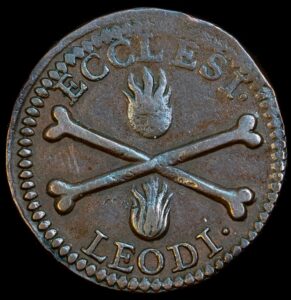 Token #5 Reverse: Tongues of fire each set above and below two crossed bones. A single dot is present after “ECCLESI” and after “LEODI”. The word “LEODI” is oriented right side up. The upper portion of the flaming ball, legend and dots are typically weakly struck.
Token #5 Reverse: Tongues of fire each set above and below two crossed bones. A single dot is present after “ECCLESI” and after “LEODI”. The word “LEODI” is oriented right side up. The upper portion of the flaming ball, legend and dots are typically weakly struck.
Legend Description: ECCLESI LEODI (Latin for “The Church of Liège”)
Reference: Renesse Plate 72 #6, OL Eklund #86
Note: This variety is considered the most common.
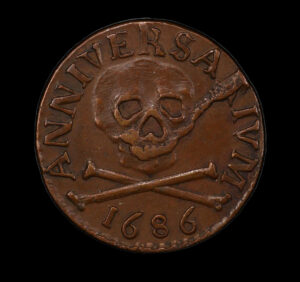 This 1686 variety has a pronounced die crack that I refer to as the ” Davy Jones variety “. The die crack resembles a skull with a snorkel in its mouth.
This 1686 variety has a pronounced die crack that I refer to as the ” Davy Jones variety “. The die crack resembles a skull with a snorkel in its mouth.
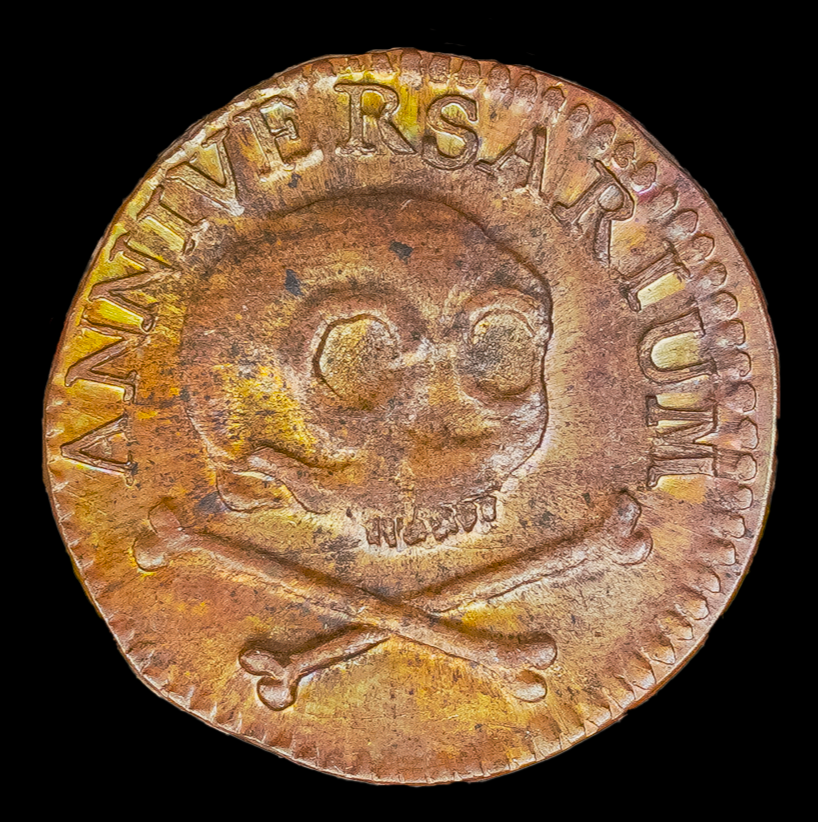
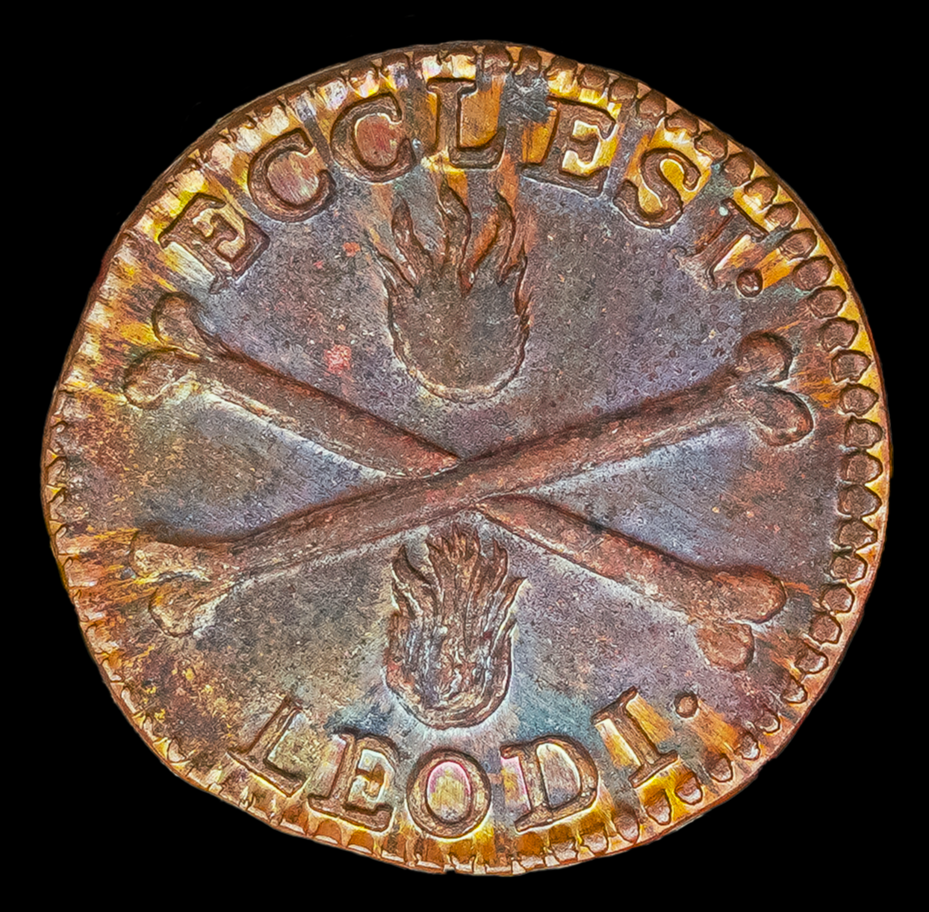
This specimen is a very rare die variety of the most common type. Most likely a very early die strike, this particular variety has notable raised orbital bones around the eye sockets. This particular specimen was struck very well and reveals all of the individual teeth on the skull. It is exceptionally well preserved with beautifully golden and bluish toned surfaces. You won’t see any quite as nice as this one!
A similar example can be seen here: https://www.ngccoin.com/certlookup/4675162-001/64/
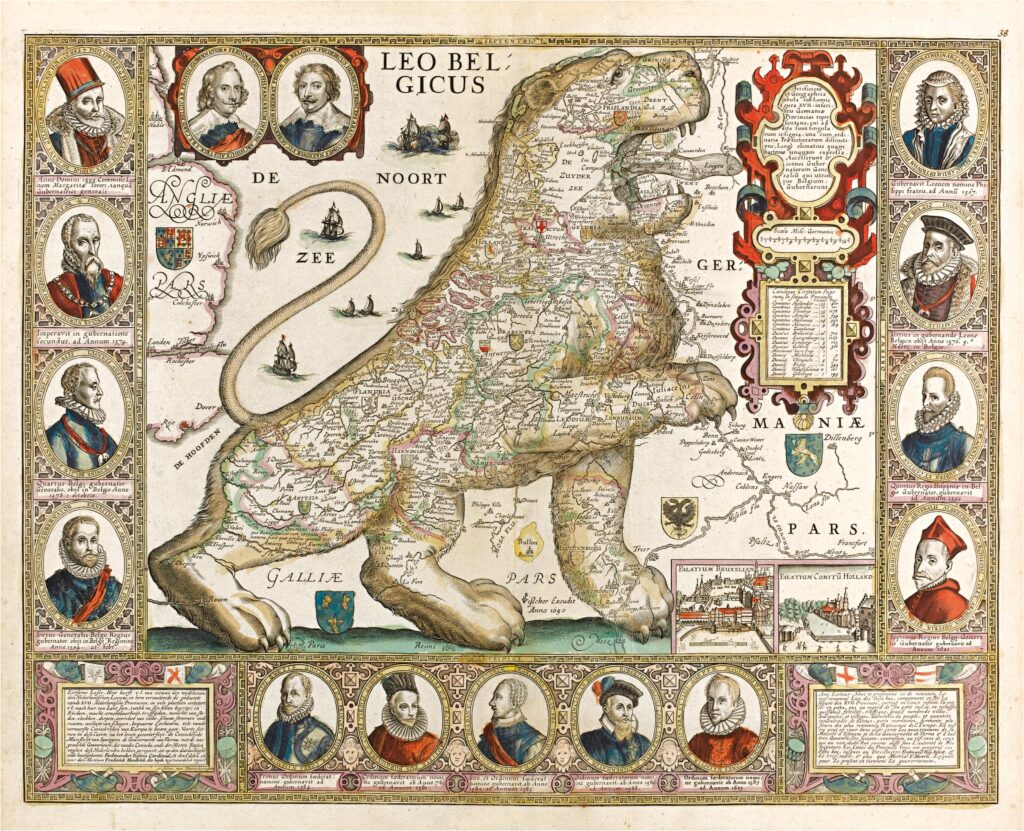
This famous and very rare map is from the period when Saint Lambert Communion Tokens were minted and is known as the Leo Belgicus (The Lion of Belgium) map. It was created by Claes Jansz Visscher in 1650. It shows the 15 governors of the Netherlands and commemorates the Dutch independence from Spain. If you look closely, you can see the city of Liège on the raised right forearm of the lion and the city of Maastricht, where Saint Lambert was born directly above.
This map below was created by the Flemish scholar and geographer Abraham Ortelius (1527-1598). It was published in the first edition of his Theatrum orbis terrarum (Theater of the world) in 1587 and illustrated the diocese of Liège. If you look closely near the center, you will see the church at the city of Liège and directly to the East, the city of Masstricht.
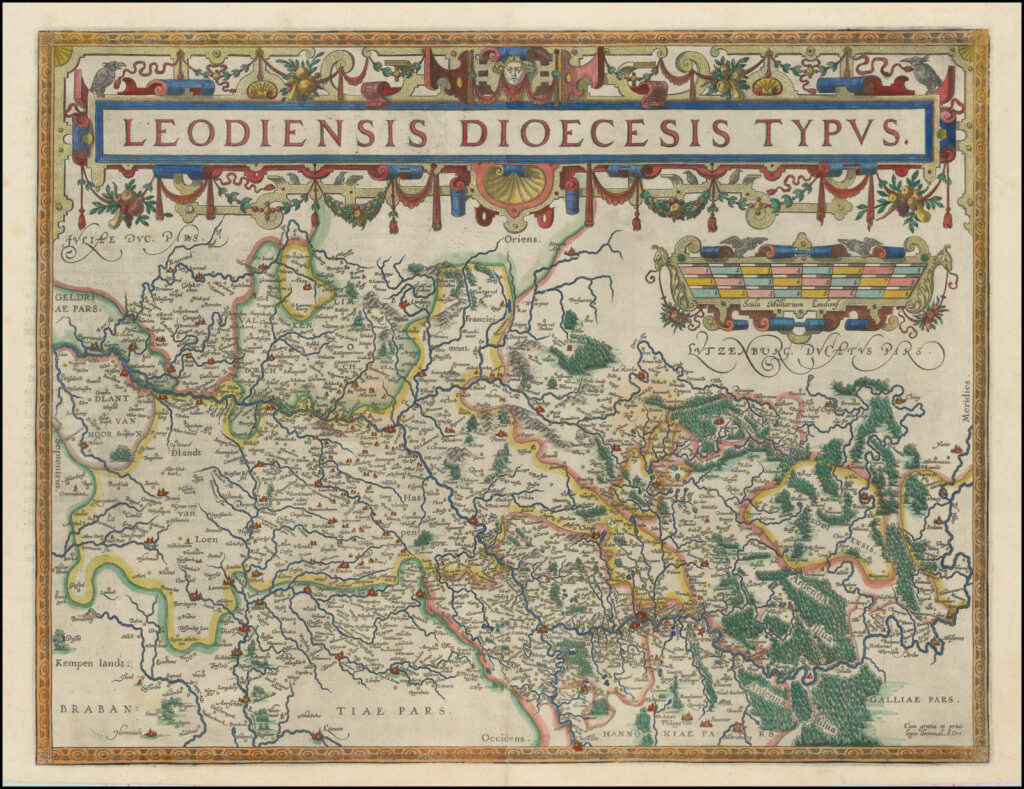
This beautiful map below was created in 1650 by Dutch cartographer Joan Blaeu (1596-1673) and provides a detailed overview of the city of Liège during the period and the cathedral of Saint Lambert at the center. Another illustration of the city can be found in the “Theatrum ichnographicum omnium urbium et præcipuorum oppidorum Belgicarum XVII” (Accurately Delineated Ichnographic Plans of All the Cities and Towns in the 17 Provinces of the Netherlands) by Frederick de Wit (1630-1706). Here is a link to this work held by the US Library of Congress.
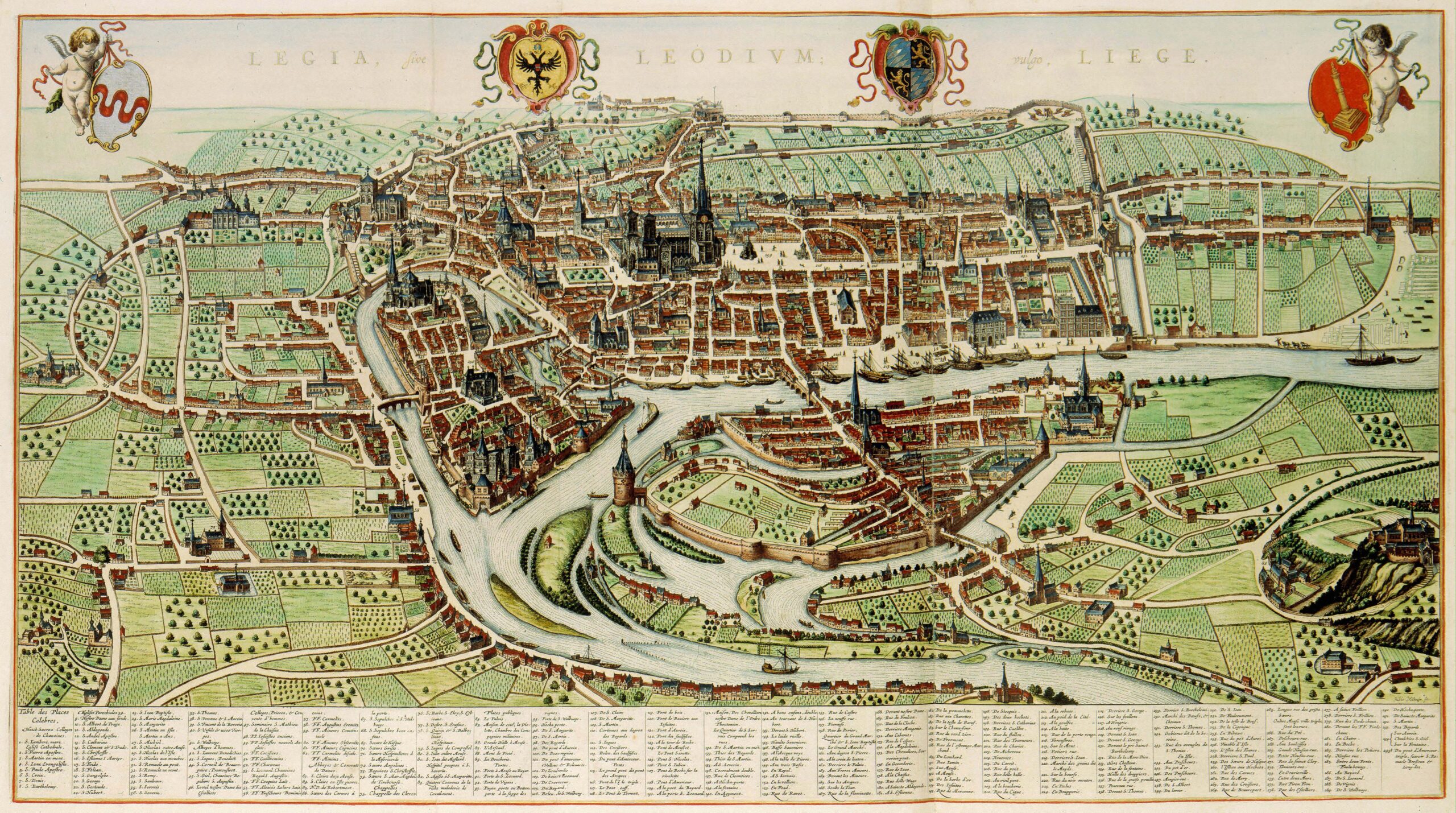
References:
- Renesse-Breidbach, Clément W. from: Numismatic History of the Bishopric and Principality of Liège 1831 (Numismatic History of the Bishopric and Principality of Liège by: Renesse-Breidbach, Clément W. Published in 1831) ‘ Renesse-Breidbach, Clément W. from: Numismatic History of the Bishopric and Principality of Liège’, Bild 387 von 406 | MDZ (digitale-sammlungen.de)
- In Belgian Numismatic Review 1850. Published in Brussels in 1850, pages 124-126
- In Belgian Numismatic Review 1875. Published in Brussels 1875, pages 252-254
- To view digital copies of “ In Revue Belge de Numismatique ” for 1850 or 1875, visit the Royal Numismatic Society of Belgium at http://www.numisbel.be/inhoudstafel.htm
- Charity Tokens of the Netherlands by OP Eklund published in 1948 by the American Numismatic Association.
- The coins of the Principality of Liège : From Notger to Henry of Guelders (972-1274) By Jean-Luc Dengis
- Medals of Belgium https://www.lodenpenningen-belgie.be/447632879/447714231
- Jetons Et Méreaux – From Louis IX Until the End of Bonaparte’s Consulate by Rollin & Feuardent (published in Paris 1915) See items 14586-14590 in the catalog. Here is the link to the imaged catalog: https://gallica.bnf.fr/ark:/12148/bpt6k378629f/f314.item
- B eschreibung der bekanntesten Kupfermünzen. Bände I – VI und Registerband.( Faksimiledruck der Erstausgabe aus dem Jahre 1858 ) “Description of the most famous copper coins” By Neumann, J. Kupfermünzen 1858 Published by Leipzig, 1966
- “ Essay D’Un Dictionnaire Descriptif General Des Mereaux Belges ” (Essay on a General Descriptive Dictionary of Belgian Tokens) Numismatic Pocket #29, By: Jean Justice, republished in 1982 (pp. 16-17, nos. 40-44)
- Lit.: Dengis, JL., The coins of the Principality of Liège, IV. Special coins, tokens, medals, mereaux, trebuchets. Wetteren: Moneta, 2007, p. 118-119, No. Me.01-06.
- Petit de Rosen, MJ Catalog of medals, tokens and coins of the chapters, corporations and families of the former country of Liège.
Written by Sean Scott.
If you have any questions regarding Saint Lambert or other memento mori type tokens, please contact Sean Scott at Sean@CommodoreCoins.com .

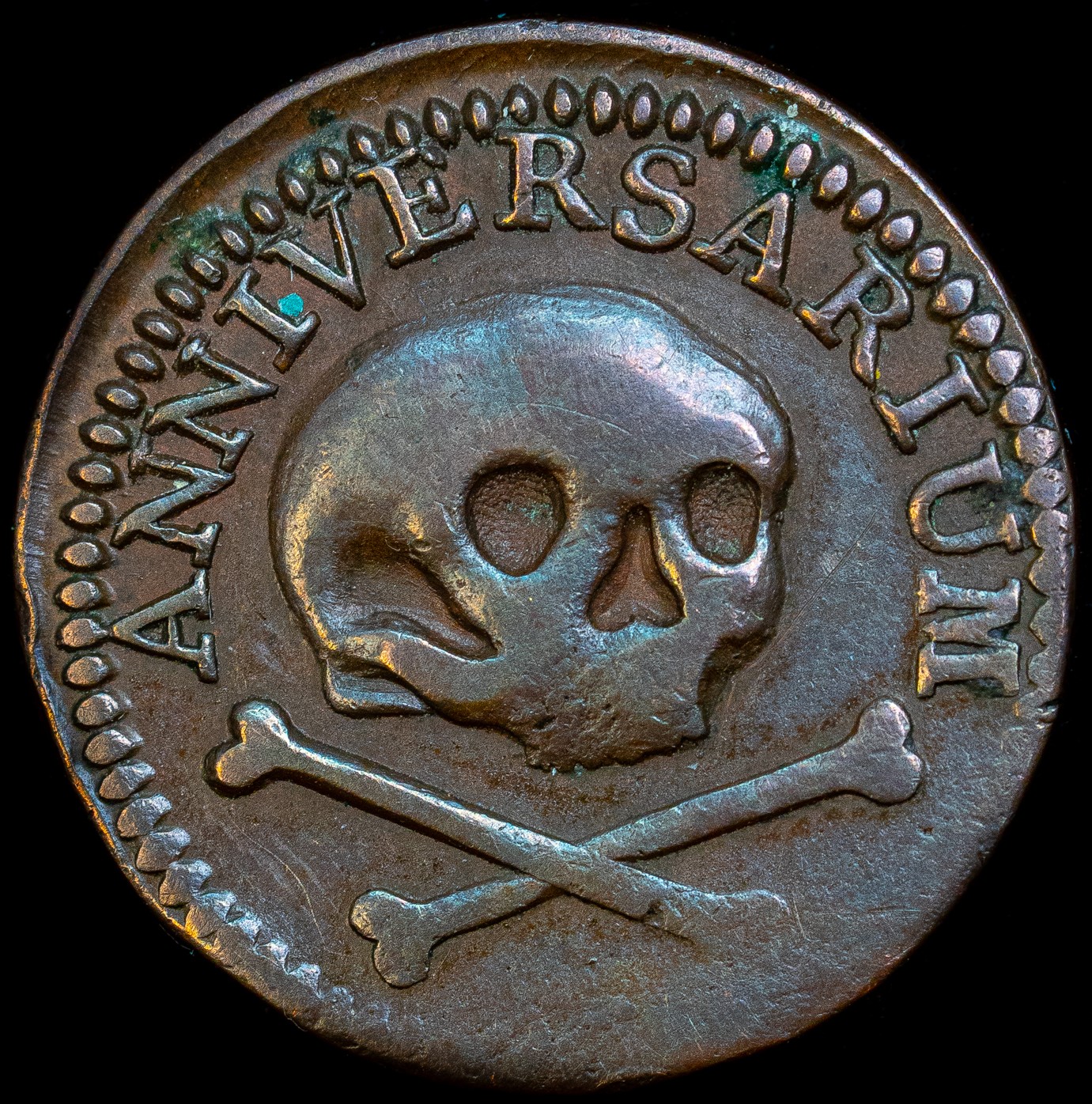
Leave a Reply